Prolific painter of Florida landscapes is focus of new book by Palm Beach couple
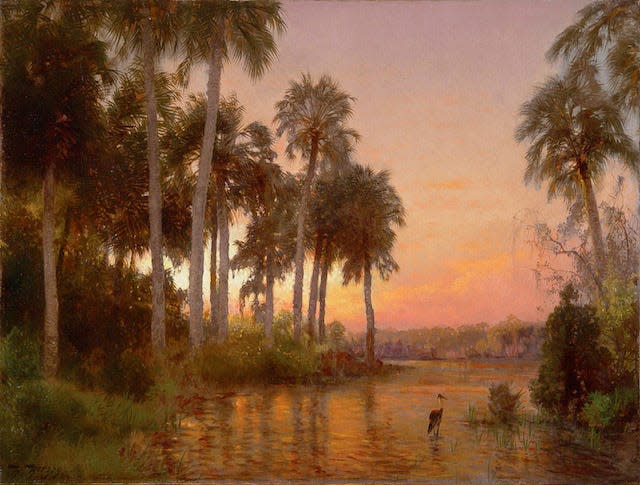
- Oops!Something went wrong.Please try again later.
The work and life story of a prolific artist who had a love for Florida’s natural beauty and painted more than 300 landscapes depicting its untamed palmetto hammocks, waters and forests is the subject of a new book by Palm Beachers Deborah and Edward Pollack.
Hermann Herzog: His Remarkable Life, Unrivaled Florida Work and Rightful Place in American Art History, is the first book the couple has produced together. Published July 3 by Blue Heron Press, it’s the 10th book Deborah Pollack has written.
More: Gallery owner and author Deborah Pollack reflects on artsy, fun side of Palm Beach
Born in Bremen, Germany, in 1832, Herzog immigrated to Philadelphia in 1871, and spent winters creating oil paintings in Florida from the early 1890s until around 1912. He also traveled throughout the U.S. and Mexico. One of his prize-winning paintings from the West is “Sentinel Rock, Yosemite, California.”
With 35 color plates of Herzog’s Florida paintings from a private collection, plus many other smaller color photos, the $175 limited edition is also a luxury coffee table book. Available at www.HermannHerzog.com, it is also available in signed copies at the Flagler Museum.
The Pollacks have owned and operated Edward and Deborah Pollack Fine Art since 1981. The gallery specializing in 19th- to mid-20th-century American art is on the second level of 205 Worth Ave.
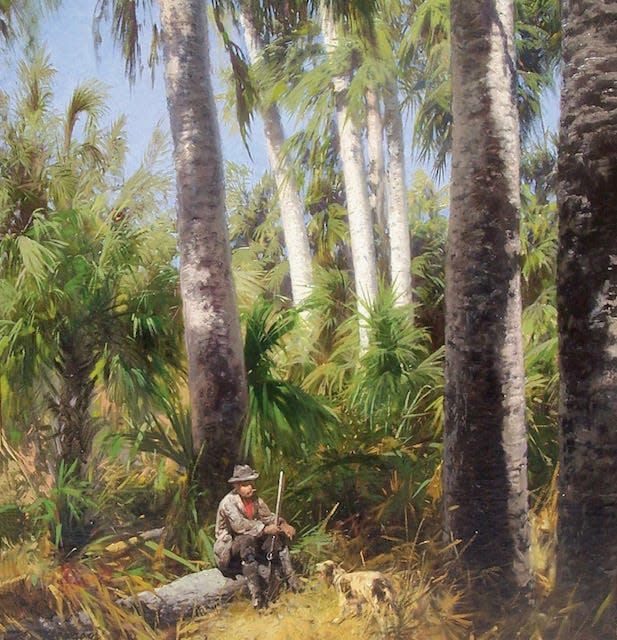
“Herzog painted all over Florida. There is a map in the book. One of those places was Palm Beach,” Deborah Pollack said. “He was painting in Palm Beach when most of it was jungle and swamp. The Royal Poinciana Hotel opened in 1894. Just off the hotel property, there were jungles. He went all over Florida depicting the wilderness. He was a landscape painter, but he included the Florida native birds and other animals in their natural habitat.”
While in Palm Beach, Herzog used what was then known as the Lake Worth Post Office on the island as his address. He traveled by train to the area, then by boat, carrying his oil paints, brushes and canvases as he trekked on foot through the wilderness.
Herzog initially fell in love with Florida after visiting his son Hermann Jr. in Gainesville. His oil paintings of its virgin terrain included wildlife such as deer, herons, feral pigs (razorbacks) and bears, as well as hunters and fishermen.
“The book was published July 3, 11 years to the day when my husband and I started writing this book,” Deborah Pollack said. “The research was incredibly extensive. We uncovered so many truths about Herzog and we corrected numerous inaccuracies.”
For example, he lived to be 99, not 100, as was previously thought. Like his first son, his second son Lewis Herzog was born in Düsseldorf, Germany, and not in Philadelphia as reported by many. Even Hermann Herzog’s immigration to the U.S. had been erroneously reported as 1869, when the correct year was 1871.
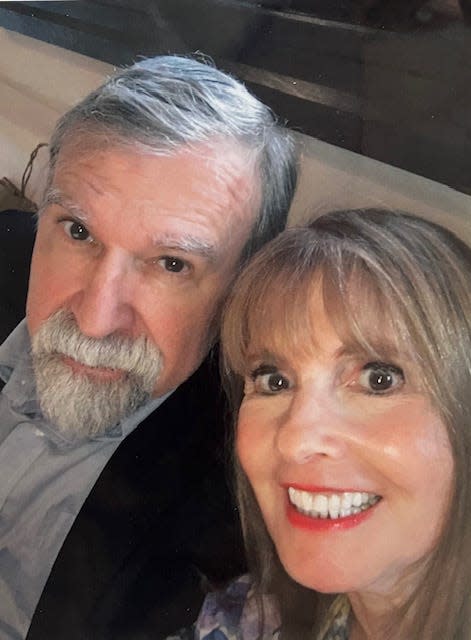
“Ed would be up early in the morning calling Germany to get archives sent to him. They would not only send them to him, but they translated them. I would be contacting American museums and other archival repositories to obtain letters from artists to Herzog, and from Herzog to artists, and letters from artists writing to each other about Herzog,” Deborah Pollack said.
“It is a fascinating story of his life of a family. It is a love story between him and his wife as well as an art historical study,” she said. “In that respect, Ed thought of comparing Herzog’s Florida work with that of other great artists, including Winslow Homer and Martin Johnson Heade, to illustrate Herzog’s mastery.”
“The main purpose of this book is to show that Herzog was the unrivaled master of the Florida landscape, outshining the likes of Winslow Homer, Martin Johnson Heade and George Inness,” Edward Pollack said.
While in Europe, Herzog sold his paintings from the Düsseldorf studio and through the Philadelphia jewelry store Bailey, Banks & Biddle, which also handled paintings then. “Some critics have written that Herzog ‘followed his work to the U.S.’ He was already a big success here,” Deborah Pollack said.
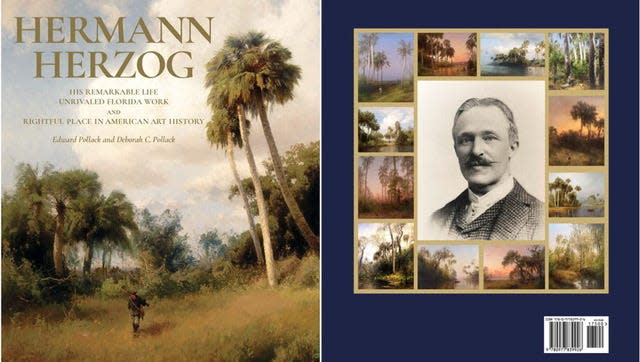
More: People: Florida painters are focus of Deborah Pollack’s gallery, books
Herzog was trained to revere nature
The book’s publication date was also the anniversary of the Federal Migratory Bird Treaty Act of 1918, designed to protect migratory bird species. Back then, many Florida wading birds, such as herons and egrets, were killed for feathers for the hat industry.
Connected to the Hudson River School of artists, Herzog was trained to revere nature and faithfully portray it.
“Some of his paintings look more misty. That is because of the time of day and the atmosphere. He has been called a Barbizon artist, (referring to) a technique started in France. In truth, he let nature lead his brush,” Deborah Pollack said.
Herzog became a U.S. citizen in 1876 and brought his wife Hermine and sons from Europe in 1877.
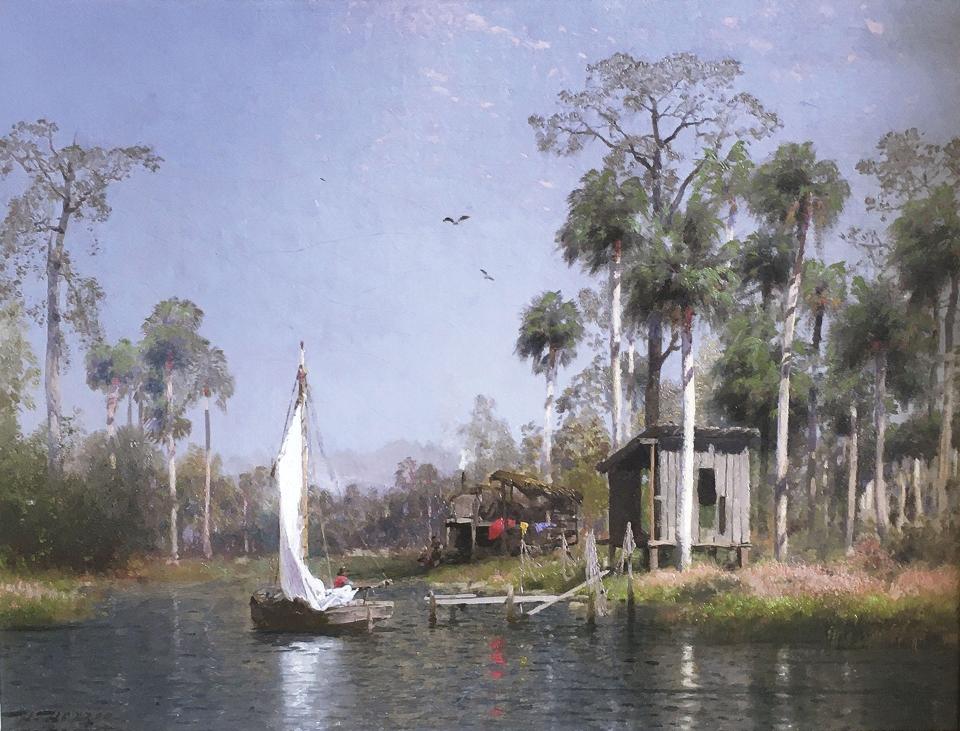
Herzog had studied at the Düsseldorf Academy, and honored nature in the Düsseldorf tradition. He painted throughout Europe in Germany, Italy, Switzerland, Holland and Norway. His patrons included Queen Victoria and Grand Duke Alexander of Russia.
“Artists from the Düsseldorf School were considered as the premier artists in the world,” Deborah Pollack said. “He was left out of American art history books of the period. They thought he was German, even though he became a United States citizen in 1876.”
Pollack, who is from Philadelphia where Herzog lived most of his life, was familiar with his work, and the couple owns 35 of his Florida paintings.
“His paintings have not been as well-known to the public as they should be. He is represented in many museums,” she said, including the Metropolitan Museum of Art in New York, and the National Gallery of Art in Washington, D.C. At least six Florida museums own one or more of his paintings. Among those are the Cummer Museum of Art in Jacksonville, the Orlando Museum of Art and the Samuel P. Harn Museum of Art in Gainesville.
More: It's as sweet: GAVLAK Palm Beach 's 'Tupelo Honey' evokes the hot days of summer
Some of his paintings are labeled by location, and others are not. Herzog traveled as far south as Punta Rassa on the Gulf Coast and the Everglades. One painting of a hunter sitting on a log resembles Palm Beach pioneer Charles John Clarke, who wintered in Palm Beach as early as 1890 with his family.
Herzog was known as an artist who produced paintings quickly. His estate included 1,000 paintings, but he produced approximately 3,000 oil paintings during his lifetime. In the early years of his career, he was driven to sell his works after experiencing a lower middle-class childhood.
Investment in Pennsylvania Railroad made Herzog wealthy
“Another reason why he became obscure is that he became very wealthy. He invested in Pennsylvania Railroad stock. One of his friends was involved in the Pennsylvania Railroad,” Pollack said. “By 1900, Herzog was worth a lot of money. He took the profits from his numerous art sales and invested in the stock.”
By 1900 his net worth was more than $3 million, the equivalent of $100 million today. So, he didn’t care to sell any more, and kept more than 1,000 of his paintings at his Philadelphia home. His descendants kept the paintings, too. It wasn’t until around 1970 that they were released to the art market.
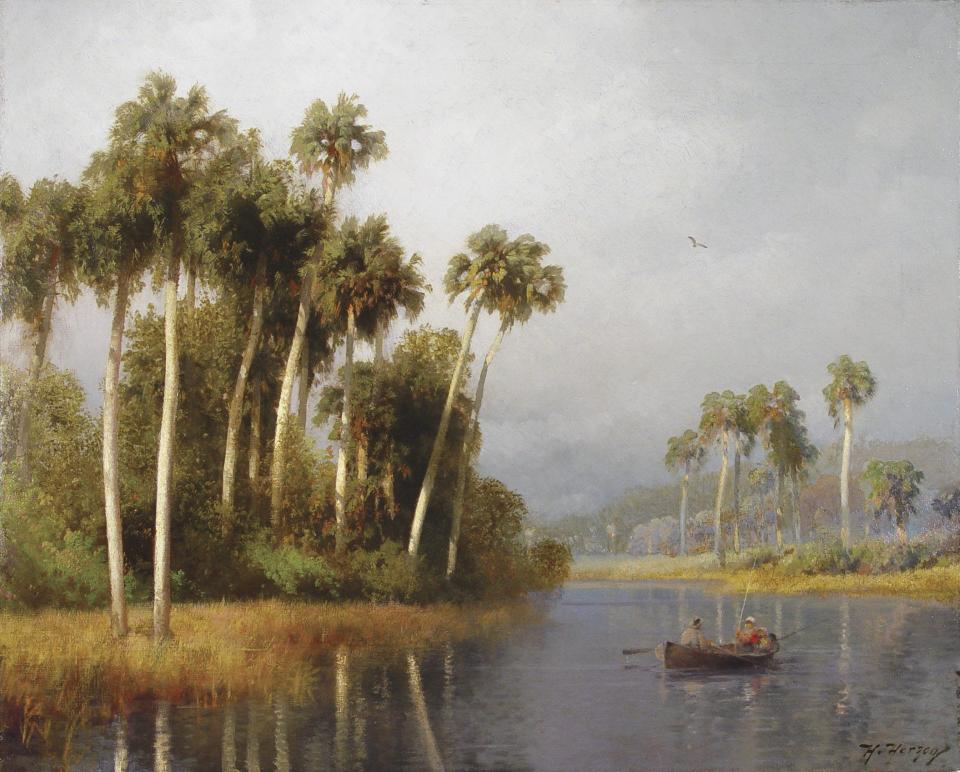
One of Herzog’s Florida paintings sold for $487,000 at a public auction, Deborah Pollack said.
Like the Herzog book, many of Pollack’s books have a Florida focus. Earlier this year, she published her ninth book, Florida Sculptors and Their Work: 1880-2020. She worked on the book for two years after realizing there was no book written exclusively about Florida sculptors.
Organized geographically, the book features around 100 sculptors who have lived in Florida. Among Palm Beach sculptors included are Thomas Shields Clarke, the son of Charles John Clarke; Gertrude Vanderbilt Whitney; and Clarence Percival Dietsch.
Photos of Leo Lentelli’s works in the book include The Breakers' Florentine Fountain and another he designed for the Boca Raton Resort & Club and others. J. Clinton Shepherd’s model for the proposed statue of the Barefoot Mailman is also pictured, as is his model for a Henry Morrison Flagler statue.
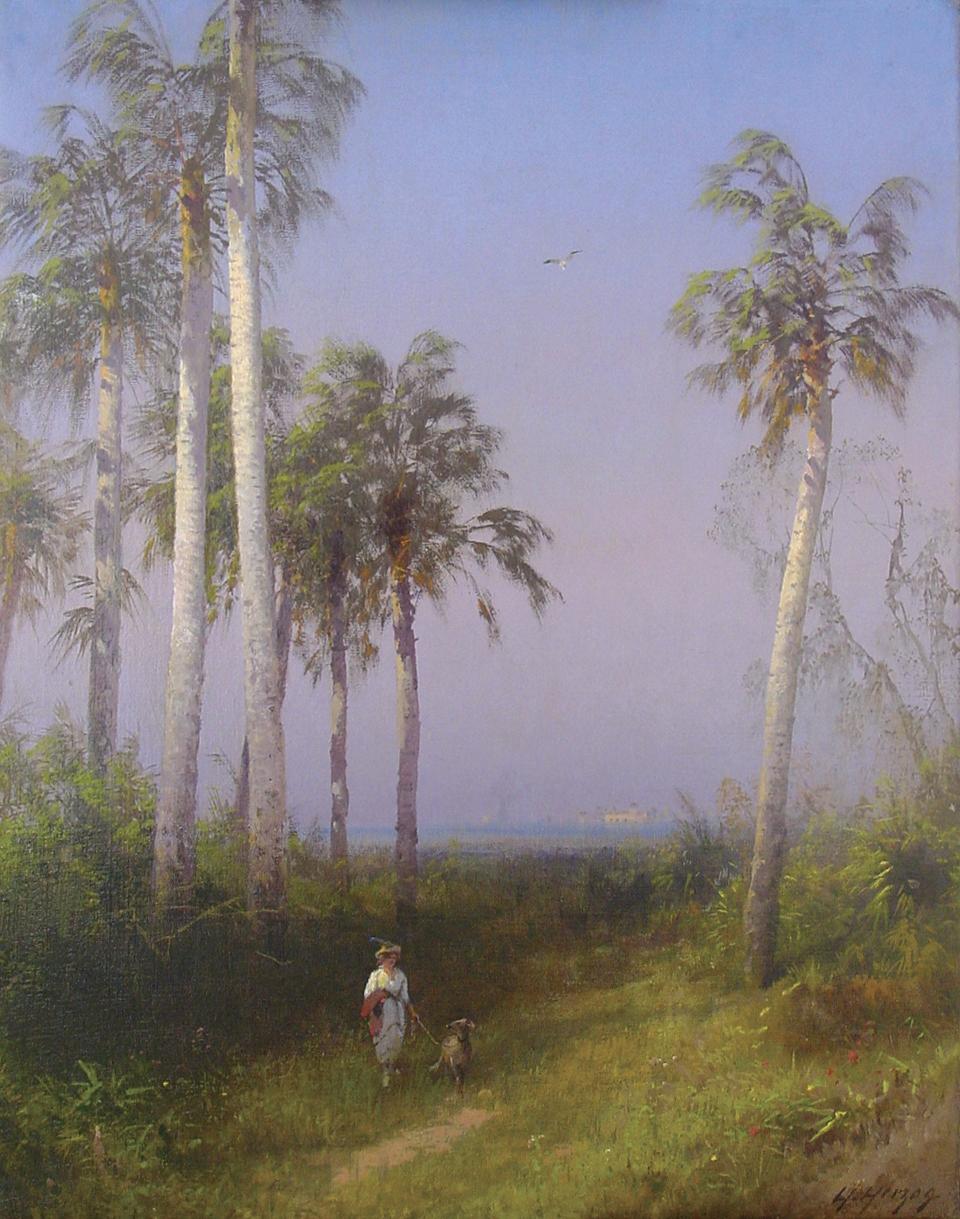
Modern-day sculptors such as Palm Beacher Susan Phipps Cochran and a photo of her with her sculpture of giant ants are noted in detail. West Palm Beach sculptors Augusta Savage and Ann Weaver Norton, as well as Luis Montoya and Leslie Ortiz, are included, along with many other artists’ sculptures.
Pollack has been called an art detective, and she enjoys uncovering the facts about art and artists.
“I was a big fan of show-and-tell when I was in grade school,” Pollack said. “The reason I created the sculptor book was that during the COVID lockdown, I was very bored, and had gained seven pounds from baking so much.”
“We sat around in our pajamas, and we went online. I said, ‘You know what, I had better get something to do,'” she recalled.
The research began as she delved into the rich history of Florida sculptors. She says her husband's love of sculpture inspired her to write the book, but so did Florida itself.
“I wanted to give Florida its due for all the wonderful work it has provided. It is kind of like a love letter to Florida," she said.
This article originally appeared on Palm Beach Daily News: Prolific painter of Florida landscapes is focus of new book by Palm Beach couple

